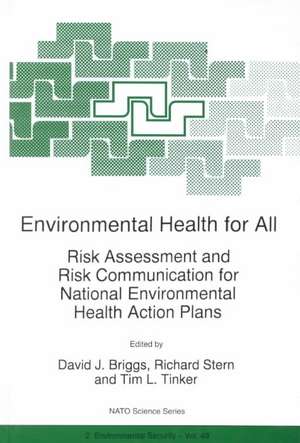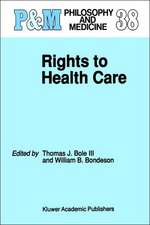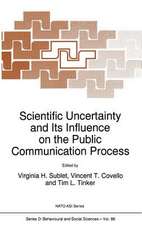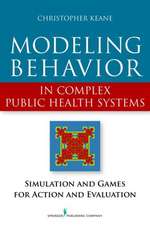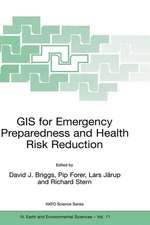Environmental Health for All: Risk Assessment and Risk Communication for National Environmental Health Action Plans: NATO Science Partnership Subseries: 2, cartea 49
Editat de David J. Briggs, Richard M. Stern, Tim L. Tinkeren Limba Engleză Hardback – 31 dec 1998
| Toate formatele și edițiile | Preț | Express |
|---|---|---|
| Paperback (1) | 1409.69 lei 43-57 zile | |
| SPRINGER NETHERLANDS – 31 dec 1998 | 1409.69 lei 43-57 zile | |
| Hardback (1) | 1416.66 lei 43-57 zile | |
| SPRINGER NETHERLANDS – 31 dec 1998 | 1416.66 lei 43-57 zile |
Din seria NATO Science Partnership Subseries: 2
- 15%
 Preț: 638.43 lei
Preț: 638.43 lei - 5%
 Preț: 1420.29 lei
Preț: 1420.29 lei -
 Preț: 390.84 lei
Preț: 390.84 lei - 18%
 Preț: 949.90 lei
Preț: 949.90 lei -
 Preț: 401.24 lei
Preț: 401.24 lei - 15%
 Preț: 653.14 lei
Preț: 653.14 lei - 5%
 Preț: 1414.64 lei
Preț: 1414.64 lei - 15%
 Preț: 642.18 lei
Preț: 642.18 lei - 18%
 Preț: 1846.40 lei
Preț: 1846.40 lei - 18%
 Preț: 949.90 lei
Preț: 949.90 lei -
 Preț: 380.07 lei
Preț: 380.07 lei - 15%
 Preț: 643.84 lei
Preț: 643.84 lei - 18%
 Preț: 1839.63 lei
Preț: 1839.63 lei -
 Preț: 416.64 lei
Preț: 416.64 lei - 18%
 Preț: 1234.77 lei
Preț: 1234.77 lei - 18%
 Preț: 1834.90 lei
Preț: 1834.90 lei - 18%
 Preț: 950.96 lei
Preț: 950.96 lei - 15%
 Preț: 655.78 lei
Preț: 655.78 lei -
 Preț: 403.53 lei
Preț: 403.53 lei -
 Preț: 381.98 lei
Preț: 381.98 lei - 18%
 Preț: 1836.94 lei
Preț: 1836.94 lei - 15%
 Preț: 645.47 lei
Preț: 645.47 lei - 18%
 Preț: 946.87 lei
Preț: 946.87 lei - 18%
 Preț: 1227.99 lei
Preț: 1227.99 lei - 18%
 Preț: 1232.57 lei
Preț: 1232.57 lei -
 Preț: 398.15 lei
Preț: 398.15 lei - 18%
 Preț: 1232.71 lei
Preț: 1232.71 lei - 18%
 Preț: 1223.88 lei
Preț: 1223.88 lei - 18%
 Preț: 1228.77 lei
Preț: 1228.77 lei
Preț: 1416.66 lei
Preț vechi: 1491.22 lei
-5% Nou
Puncte Express: 2125
Preț estimativ în valută:
271.07€ • 283.79$ • 224.30£
271.07€ • 283.79$ • 224.30£
Carte tipărită la comandă
Livrare economică 07-21 aprilie
Preluare comenzi: 021 569.72.76
Specificații
ISBN-13: 9780792354529
ISBN-10: 0792354524
Pagini: 278
Ilustrații: XI, 278 p.
Dimensiuni: 155 x 235 x 18 mm
Greutate: 0.59 kg
Ediția:1999
Editura: SPRINGER NETHERLANDS
Colecția Springer
Seria NATO Science Partnership Subseries: 2
Locul publicării:Dordrecht, Netherlands
ISBN-10: 0792354524
Pagini: 278
Ilustrații: XI, 278 p.
Dimensiuni: 155 x 235 x 18 mm
Greutate: 0.59 kg
Ediția:1999
Editura: SPRINGER NETHERLANDS
Colecția Springer
Seria NATO Science Partnership Subseries: 2
Locul publicării:Dordrecht, Netherlands
Public țintă
ResearchCuprins
One. Developing NEHAPs: practice and experience.- 1. National Environmental Health Action Plans: background and process.- 2. The NEHAP experience in the Czech Republic, Romania and Poland.- 3. Setting priorities for environmental health risks in Sweden.- Two. Risk Assessment: Exploring Relationships Between Environment and Health.- 4. Sources and consequences of uncertainty in risk estimates.- 5. Outbreak of baldness in children in Sillamäe, Estonia.- 6. Health effects of exposure to metals from manufacturing plants.- 7. Is iodide a confounding or effect modifying factor of liver cirrhosis?.- 8. Structural-functional state of the bone-muscular system in people exposed to low doses of ionising radiation.- Three. Risk Assessment: Mapping and Modelling.- 9. Tools for risk assessment: statistical and spatial methods.- 10. Environmental modelling in the NEHAP process.- 11. Tools for risk assessment: Geographic Information Systems.- 12. Monte Carlo simulations in risk assessment: cancer risk in the Polish coke industry.- Four. Risk Communication.- 13. Promoting active public participation.- 14. Putting risk communication policy into practice: a U.S. federal perspective.- 15. Priority setting of environmental and health policy options.- 16. Presenting decision-makers with their choices: environment health indicators for NEHAPs.- Five. Issues and Research Needs.- 17. What is risk?.- 18. Quantifying the unquantifiable and comparing the non-commensurate.- 19. Reality versus perception, and values versus science in risk assessment and risk perception.- 20. Coping with complexity in environmental health management and policy.- References.- Appendix 1. Workshop Conclusions and Recommendations.- Appendix 2. Workshop Participants.
